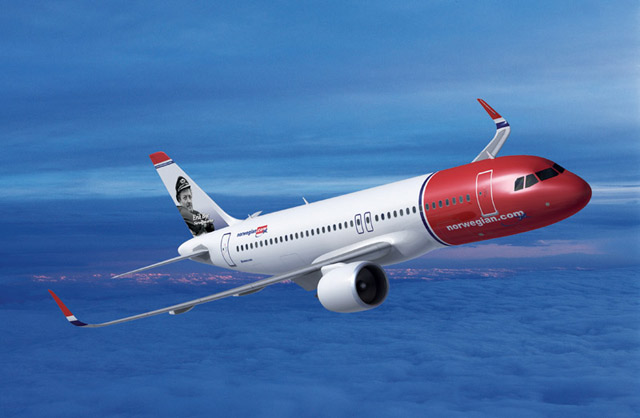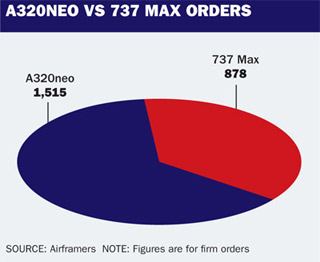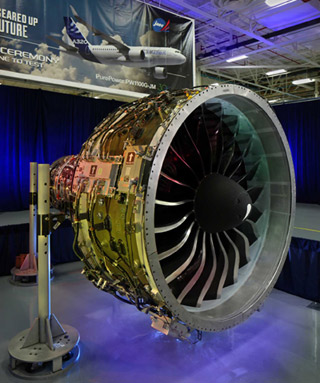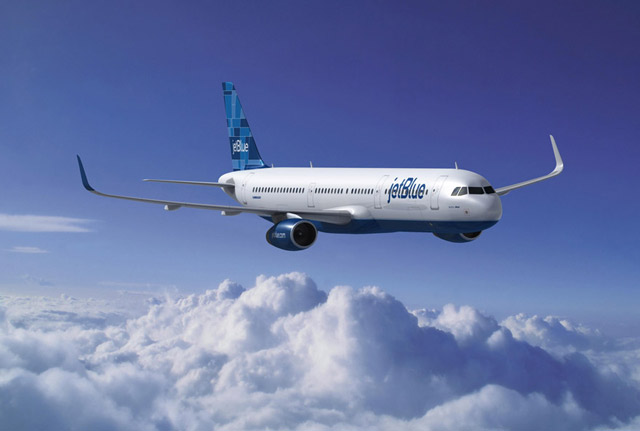Only a few weeks after MSN6000 rolls off the Airbus A320 final assembly line, the airframer aims to pass a more significant milestone by completing the first re-engined version of the single-aisle type. Airbus has identified a provisional airframe which will be the first to emerge as the A320neo. However, programme chief Klaus Roewe is reluctant to publicise the precise serial number - beyond saying it will be in the "early 6000s" - to avoid inevitable headlines about technical problems should its position be pushed back by a few slots. Not that any such concerns are worrying the development team. "We're precisely on track with the schedule," insists Roewe. "We're passing the milestones at a very high level of quality."
 |
|---|
Airbus Norwegian gave the programme a big boost by ordering 100 Neos |
Whether the A320neo is really history's fastest-selling jetliner depends on whether anyone agrees with gradients drawn on the sales charts of chief operating officer for customers John Leahy. But two years after the re-engined twinjet was unveiled in December 2010, the aircraft has passed 1,500 firm orders - the equivalent of more than two per day - without any cancellations or conversions, a backlog which has yet to include another 130 jets, for American Airlines, which Airbus nonchalantly put aside while the carrier sorted out its Chapter 11 restructuring. Half the firm orders were booked within 250 days of launch. While Virgin America has muted the fanfare of its launch order by opting to push back deliveries by four years, the creation of earlier slots will hardly worry Airbus, whose primary concern has been a scarcity of delivery positions, particularly given limits of the supply chain to accommodate further production rate increases. A320 production has risen to 42 per month but, says the airframer, there is "no commitment" to take this any further.
 Rival Boeing is still tweaking its own re-engined 737 Max, introducing larger display screens to the cockpit and tightening the aerodynamics. But Airbus intends to put the A320neo into service in October 2015, some two years ahead of its competitor. Having already claimed the A320neo is the more efficient twinjet, and aware of the shorter timeframe, the airframer is resisting any temptation to tinker with the design. "We're following a minimum change approach," says A320neo chief engineer Pierre-Henri Brousse, adding that the cockpit will only be modified to adapt to the new engine configuration. "There are no fundamental changes in terms of the technical assumptions," he says. While Airbus will study potential improvements to the aircraft as a matter of routine, these efforts will run parallel to, and separate from, the main development path.
Rival Boeing is still tweaking its own re-engined 737 Max, introducing larger display screens to the cockpit and tightening the aerodynamics. But Airbus intends to put the A320neo into service in October 2015, some two years ahead of its competitor. Having already claimed the A320neo is the more efficient twinjet, and aware of the shorter timeframe, the airframer is resisting any temptation to tinker with the design. "We're following a minimum change approach," says A320neo chief engineer Pierre-Henri Brousse, adding that the cockpit will only be modified to adapt to the new engine configuration. "There are no fundamental changes in terms of the technical assumptions," he says. While Airbus will study potential improvements to the aircraft as a matter of routine, these efforts will run parallel to, and separate from, the main development path.
Roewe says: "We didn't feel it was appropriate, for the [A320neo], to change the display. It's not very convenient for the pilot. We're giving preference to our schedule as we're two years ahead of the other guys. We want to keep the [aircraft] clear of any further design evolution."
Airbus has reached the crucial MG5 maturity gate, closing off the conceptual design for the Pratt & Whitney PW1100G-powered version in June and that for the CFM International Leap-1A version in October. The A319neo reached this stage at the same time, as its similarity allows Airbus to treat both variants as the same aircraft. "We're fully into the detailed design now," says Roewe.
The most prominent evidence of progress on the aircraft is the completion of the first PW1100G test engine, unveiled in late October. Eight of these powerplants will be built and run during the next two years. CFM International has started producing initial parts, including the fan disk, for the Leap test example which will start runs in the third quarter of 2013. Having been selected to power 596 aircraft, the Leap-1A has a slight edge over the PW1100G, which has been chosen for 574. Engine selections have yet to be made for the other 345 A320neos on firm order.
The new powerplants require a new pylon structure and this is one of the higher-profile changes to the airframe. Brousse says the pylon and nacelle have "reached their final shape". Roewe adds that the pylon manufacturing process for the basic A320 will remain in place but a "completely new" production line for the A320neo will be established in parallel.
 |
|---|
Airbus |
Manufacturers started cutting the first metal for the A320neo earlier this year and the pace of parts production is accelerating. Roewe says that not only is the pylon in production, but many test components are being manufactured "all over the place", with photographs of components "coming in every day".
Aside from the engine, much of the nacelle, and a "significant" part of the pylon, he says sections have been built for the bleed and hydraulic systems, and initial components for the new landing-gear are in progress.
Airbus's development of the sharklet wing-tips - requiring a reinforced wing - have extended to the roll-out of the first A319, MSN5327, with the modification. It will join the flight-test campaigns already being undertaken by the initial sharklet-equipped A320 and A321.
The wing-tips will be an option on new-build A320-family jets but standard on the A320neo, and all wings will eventually be built sharklet-capable. Production of the new wings has been in place for a couple of months, says Roewe.
"We're not at full rate for the sharklet wing," he says, but adds there are "very few" airlines that do not want the option of the new wing-tips - at least for the perceived higher residual value of the airframe - and there will be a "strong ramp-up" in production.
The MG5 gate also covers the industrial preparation, but the degree of commonality with the A320 means few changes are needed to the heavy manufacturing equipment. "Almost no major jigs need to be adjusted," says Roewe, adding that specific tooling for the A320neo can be achieved simply by duplication.
The A321neo differs structurally from its smaller sisters, notably in the wing, and development remains at the MG4 gate, with progression to MG5 scheduled for next year. Eight aircraft will be manufactured for the flight-test campaign, to account for all three types and their various engine combinations. Roewe says the test and validation effort will encompass some 3,000h.
Airbus has opted against using a new MSN numbering scheme for the re-engined aircraft. Roewe says that although the airframer is "running out of MSNs" it would be "unmanageable" to start again from MSN1 for the A320neo because of potential confusion over which A320s were re-engined versions. "It's a luxury problem," he says, adding that the airframer will simply take the scheme into five digits. "It'll be the same numbering system."
 |
|---|
Airbus |
Airbus will roll out the first A320neo from its Hamburg assembly line but says all four production plants - including the new one in Mobile, Alabama - will be needed to meet demand for the type. The airframer has yet to determine how soon it could cut over to full A320neo production. Its regular A320 remains in demand, with 549 booked in the period from the A320neo's launch to the end of October. Sharklet tests have produced encouraging results on fuel-burn savings but the weight of the A320neo's economic case rests on the engines. While the airframer will have to wait for the reassurance of hard flight-test data, Roewe says the airframer's calculations over the A320neo's capabilities and maintenance costs look promising. "We'll meet the requirements on performance," he says. "We feel very comfortable."
Source: Flight International























